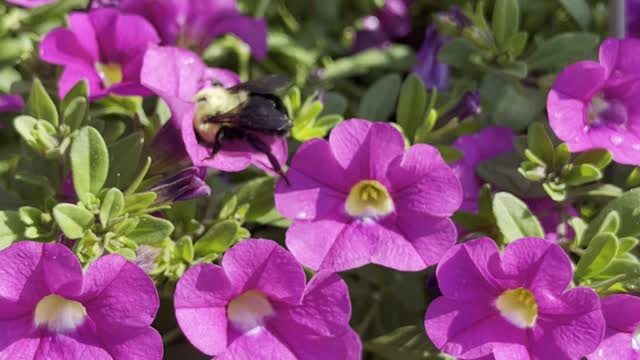Premium Only Content

Bumble Bee busy pollinating petunia flowers
This bee is busy flying from one petunia flower to the next, doing what bees do best, pollinating! They are simply fascinating to watch as they buzz along. Bumble bees use buzz pollination to access these pollen resources. In order to do this, the bumble bee will grasp the flower with its legs, place its thorax close to the anthers of the flower, and will rapidly vibrate its flight muscles, producing a strong vibration that shakes the pollen free from inside the anther.
One of the most noticeable physical traits of bumble bees is how big and hairy they are. Bumble bees are some of the largest bees and are covered in thick hair, and together this makes them great pollinators, without even trying! Bumble bees actually accumulate a positive electric charge on their hairs as they fly. Pollen is negatively charged making it electrostatically attracted to the bee, so pollen grains get stuck more readily all over their positively-charged, hairy bodies, and are transferred from flower to flower while the bee forages for pollen and nectar. Being big also means that there is more surface area that contacts the flowers and picks up pollen, especially if they have to squeeze themselves deep into a tight cone-shaped flower to access the nectar source!
Bumble bees make for good pollinators because they’re tolerant of our Canadian climate—which is more than a lot of us Canadians can say! The bumble bee’s size and hairiness doesn’t only make it better at collecting and transferring pollen passively, these are also characteristics that help to keep it warm. Aside from the hairs acting as natural insulators, a bumble bee’s large body size makes for large flight muscles which it can vibrate at high enough frequencies to generate its own metabolic heat.
Like bumble bees, other native bee species also have to survive the long, cold Canadian winters, however the bumble bee’s ability to stay warm sets it apart from other bee species when conditions are less favourable in the early spring and fall months. Bumble bees are capable of flying at much cooler temperatures (even around 10°C!) than most other insect pollinators, and this means that plants blooming at these times will also be pollinated. Sometimes even on cloudy days, very windy days, and during a light drizzle!
Needless to say these creatures help all of humanity survive on this planet by pollinating and producing our crops.
-
 3:03:45
3:03:45
The Charlie Kirk Show
4 hours agoCharlie Kirk: A Life of Faith, A Legacy That Endures
396K336 -
 3:58:08
3:58:08
The Rubin Report
5 hours agoCharlie Kirk’s Best Moments on The Rubin Report
34.1K12 -
 UPCOMING
UPCOMING
FomoTV
16 hours ago🕯 Charlie Kick Assassinated — Radical Campus Rhetoric Made This Possible | Fomocast 09.11.25
522 -
 3:08:36
3:08:36
Right Side Broadcasting Network
5 hours agoLIVE REPLAY: Latest News from the Trump White House - 9/12/25
45.7K12 -
 LIVE
LIVE
Dr Disrespect
4 hours ago🔴LIVE - DR DISRESPECT DESTROYS BORDERLANDS 4 - INSANE LOOT, CHAOS & RAGE
1,311 watching -
 1:28:34
1:28:34
Mark Kaye
4 hours ago🔴 How Charlie Kirk's Killer, Tyler Robinson, Was Caught!
31.3K25 -
 59:58
59:58
Jeff Ahern
1 hour agoFriday Freak out with Jeff Ahern
5.67K1 -
 1:29:00
1:29:00
Russell Brand
5 hours agoLaura Loomer: The Most Banned Woman in the World - SF632
71.8K115 -
 2:44:08
2:44:08
Robert Gouveia
5 hours agoCharlie's Murderer CAUGHT! Name and Details RELEASED! Deranged Libs FIRED!
19.7K18 -
 2:14:43
2:14:43
The Quartering
4 hours agoCharlie KIrk Assassin CAUGHT, Motive Revealed, Who He Was & His Confession
83.8K108